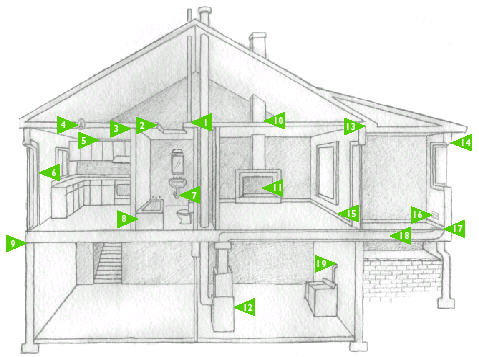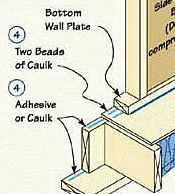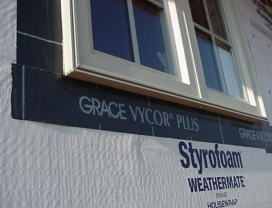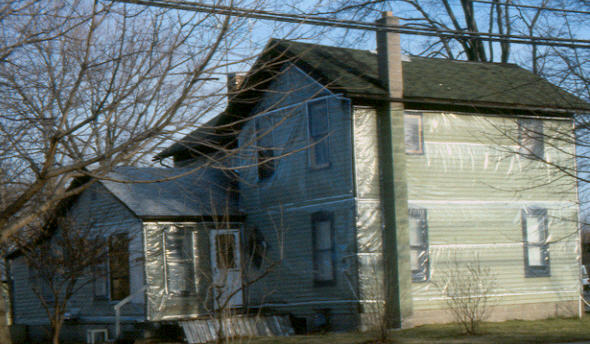Air Infiltration
Overview
Infiltration accounts for over 1/3rd of the heat loss in an average insulated house. While some infiltration is desirable – it gives a supply of fresh air to occupants and keeps building materials dryer (in winter), most houses have more infiltration (drafts) than they need.
Sources of Infiltration:

- Around plumbing vent stack
- Attic hatch
- Tops of interior walls
- Recessed light
- Behind built-in cabinets
- Around door
- Plumbing penetrations
- Around bathtub
- Sill plate
- Around chimneys and flues
- Fireplace damper
- Furnace or air conditioner air handler box
- Where additions join house
- Around window
- Behind baseboards
- Around electrical sockets
- Around duct boot and register
- Ducts
- Around dryer vent
Limiting Infiltration
The best way to limit infiltration is caulk, caulk and more caulk!
Caulk Types
The best general caulks are mostly silicone. Silicone sticks to most building materials, won’t shrink and remains workable at most ambient temperatures. Some silicone caulks have additives that allow them to be painted; otherwise, paint will not adhere to silicone. Silicone is also available in colors.
Urethane based caulks are good for concrete as they are harder and adhere well to concrete.
Expanding foam caulks are good for plugging larger gaps. Large gaps can also be stuffed with fiberglass batt scraps and then caulked over to seal air leaks.
 Latex based caulks are cheap, paintable and come in lots of colors. However, unless they have a lot of silicone added to them, they will shrink, crack and otherwise not hold up over the long term. They can be effective in plugging seams in wood siding and other areas that will be painted, as the paint will assist in holding the caulk in place and filling any gaps that develop over time.
Latex based caulks are cheap, paintable and come in lots of colors. However, unless they have a lot of silicone added to them, they will shrink, crack and otherwise not hold up over the long term. They can be effective in plugging seams in wood siding and other areas that will be painted, as the paint will assist in holding the caulk in place and filling any gaps that develop over time.
Construction adhesives can also be used as caulk between framing components, such as where the bottom sill plate of the stud wall sits on the sub-floor (See Graphic) in new construction.
House Wraps
 House wraps are materials designed to stop wind but allow moisture to pass through. They resemble the material used in a ‘Tyvek’ (brand) envelope. Some wraps are actually made of ‘Tyvek’ (brand) material without the water proofing agents that the envelopes have.
House wraps are materials designed to stop wind but allow moisture to pass through. They resemble the material used in a ‘Tyvek’ (brand) envelope. Some wraps are actually made of ‘Tyvek’ (brand) material without the water proofing agents that the envelopes have.
House wraps can save energy if properly installed. Often they are torn and punctured during installation, which reduces their effectiveness. Also, how they are finished off around windows, doors and the foundation line can make a big difference on how well they work.
 In this installation the house wrap has been finished at the windows and doors with a heavy tape over the window installation flanges.
In this installation the house wrap has been finished at the windows and doors with a heavy tape over the window installation flanges.
Obviously this measure can only be taken at the time of new construction and, with some less effectiveness, at the time of retrofitting new siding.
Weather Stripping
All doors and windows must be weather stripped to reduce infiltration but still allow function. Inexpensive products such as self-adhesive foam strips can be effective for one season control, and other products such as spring-metal and vinyl-magnetic strips can work for years.
Be sure to weather strip the garage doors, even though it may not be heated. The garage is an important buffer to the heated space. Also weather strip doors to unheated basements, 3 season porches and other semi-heated spaces. Attic access doors should be both weather stripped and insulated.
Making a House Too Tight?
 It is VERY difficult to make an existing house too tight using conventional methods. The house to the right has been wrapped completely in plastic sheeting. This is TOO extreme and should NEVER be done.
It is VERY difficult to make an existing house too tight using conventional methods. The house to the right has been wrapped completely in plastic sheeting. This is TOO extreme and should NEVER be done.
This kind of “house wrap” will not allow moisture to pass in either direction. This is sometimes done for short term pest eradication, but should NEVER be done as an energy conservation measure. This could result in moisture damage to the structure, mold problems and very poor indoor air quality. It could also cause CO (Carbon monoxide) problems if the furnace and combustion appliances cannot get enough combustion air.
In new construction it is possible to make a house tight enough that some would consider it ‘stuffy’. Opening a window on a nice day is the no-cost approach, but a continuous approach that works even on very cold days is an Air to Air Heat Exchangers. These products can be a little pricey to install, but will eliminate all concerns about a house being too tight and yet keep energy costs down.
CAUTION: Do NOT block sources of combustion air for furnaces, water heaters, fire places and other combustion appliances. Most new furnaces bring their combustion air from the outside. Building codes have also required a small amount of air to be brought into mechanical rooms, generally via a duct to the outside or attic. Never block these ducts or combustion air sources.
For more information see also Indoor Air Quality and Combustion Air
More Information
For the proper use of a vapor barrier see Vapor Barriers
Source: Air infiltration graphic from The Home Energy Saver web site Developed by the Environmental Energy Technologies Division at the Lawrence Berkeley National Laboratory located on the web at http://hes.lbl.gov/hes/makingithappen/nrr.html 8/2003; Text Bob Fegan 12/2008; house photos by Bob Fegan.
© 2008 Energy Solutions Center400 N. Capitol Street NWWashington, DC 20001 All rights reserved. Legal Contact our webmaster
